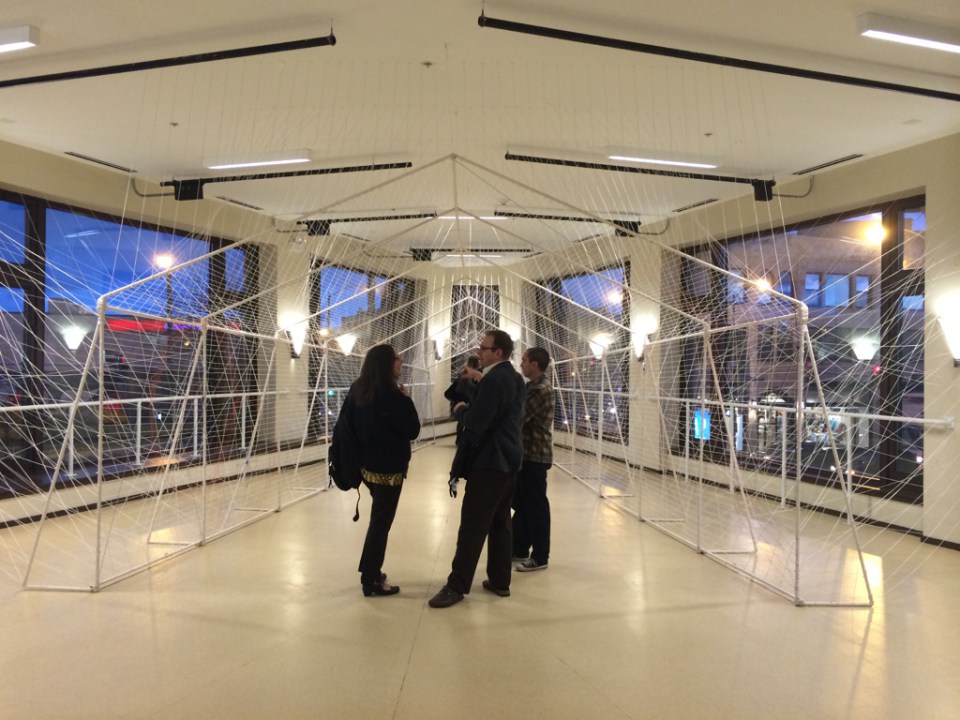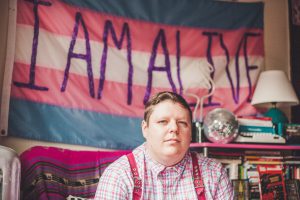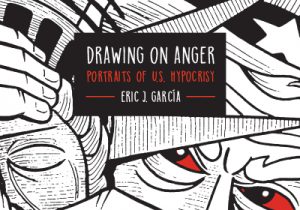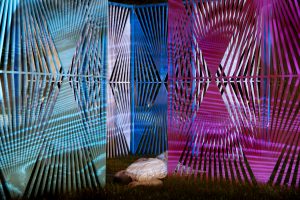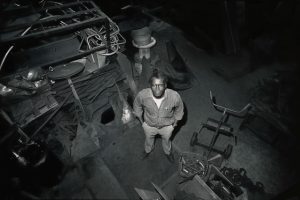RE<NEW>ALL, the title of a group exhibition by Amie Sell, Nando Espinosa, Attitude 7, Aga Furtak, and Peaceflow held at the Hairpin Arts Center, evokes the possibility of a new way of approaching gentrification, especially in Logan Square – through forging a new community where all are included, resources are shared, and displacement is fought together. Sell’s piece Warm Memory, which was installed in a communal way and which welcomed viewers to meditate on their ideas of home in a public space, functioned as an allegory of this idea. Since her work Home Sweet Home was censored and removed from the Milwaukee Avenue Arts Festival last year by Mark Fishman, a board member of I Am Logan Square, Sell has continued to help build community and fight displacement. She has become involved with We Are/Somos Logan Square, an organization dedicated to helping people in Logan Square organize and defend their right to affordable housing. (FYI: their meetings on tenants rights are super informative for anyone having issues.) Sell was kind enough to share her perspective with me on the effects of gentrification, how it shapes the landscape for artists and the arts, and the clash between property values and the way we value “home.”
Jennifer Patino Cervantes: How long have you been in Logan Square and what kind of changes have you seen in the neighborhood?
Amie Sell: I’ve been in Logan Square for 10 years. The neighborhood has experienced many changes, especially on the eastern half. The population demographics have changed and many families, working class and have been displaced, making way for younger, whiter residents. Housing and rental prices have dramatically increased and local businesses have changed to serve the new demographics. The economic structure of the neighborhood has shifted to serve a higher class.

JPC: How have those changes impacted you personally?
AS: Personally, I’ve been affected by having to pay more rent for less space. Currently I am in an affordable situation, but if my landlord decided to change that I would most likely not be able to find another affordable situation in the neighborhood. Very recently, my partner and I have been looking to purchase a home and it is highly likely that we will have to leave the neighborhood.
JPC: How have they affected your practice?
AS: My art practice as a sculptor living in rental situations continually adapts to my spatial situations. When I was in school years ago I had access to a woodshop and welding equipment, so I was able to make objects by more traditional means. Since then, I have not had the luxury and adapted to making smaller models, paper mache, found objects, softer materials and modular pieces that can be assembled and compacted into storage bins. Seeking site-specific installation situations has become a means, but also fits my sensibility and goals of my art. Creating temporary experiences instead of traditional permanent objects feels true to the conceptual layer that I strive to achieve. I do dream about having a garage with a welder and a ban saw, so it will be interesting to see how that will play into my evolving practice.
JPC: Has your idea of home evolved as a result of your experiences in Logan Square?
AS: My idea of home has evolved while living in Logan Square, but I’m not sure it was a direct correlation in the beginning. In 2010, I started to examine my personal experiences of living in many homes, having moved 27 times to date. It started as an introspective, personal project, but has evolved into trying to understand it from the point of view of my neighbors as mass displacement occurring all around me. Some days I feel that my life experiences of constant moving have left me better equipped to roll with housing changes and I have a less concrete, more ethereal idea of home. But, as I’ve become deeply involved in housing activism in the neighborhood for a number of reasons my concepts of home grow. The main driver for me is that when I am with people that are experiencing displacement or feel threatened by it, I have a very visceral connection, an understanding of what that pit in your stomach feels like when you are forced to separate your home from the physical space of your house. The uncertainty can be painful and the reality that someone with more money can take that away from you in the name of ‘business’ is harsh.

JPC: In an era of high foreclosures and rampant gentrification, how does the emotional value we place on home relate to the financial value placed on it by others?
AS: Use value and exchange value are out of balance in our economic system. The use value is the hard costs of materials, space, etc. for the structure of a home. The exchange value is the perceived value of the place because of location, marketing, perceptions of the area. Rampant foreclosures are fueling the fire of gentrification. Wall Street and misleading predatory lending practices created the foreclosure situation we are witnessing today. There is plenty of evidence that they targeted poor and minority families with adjustable rate mortgages, falsely leading them into the very warm idea of the “American Dream” of owning a home. When the bubble burst and families could no longer afford ballooning mortgage payments, they were not given opportunities to refinance. Instead, banks have seized countless properties and sold the majority off to developers and multinational corporations like Blackstone. Investment properties! Make money. Financial institutions have written white papers about it and fired up the free-market-believing business interests. This leads directly into the rampant gentrification that we see. Sky-rocketing rents, luxury developments and rehabs all aimed at young, affluent people and reclassification of neighborhood districts as “hot.”
It’s hilarious and sad to me that so many people think it is some natural force. Calling it “business” is a veil or coping mechanism for the people in control of capital to not have to examine the reality of the lives they never allow to plant roots. A disconnect. Now how do I think this relates to the emotional value of home? I think that it reinforces the construct that only people with money deserve a home that is safe, accessible, and healthy. It is somewhere in the chaos caused by uprooting that value is harvested for those that can afford it. If you attend a community meeting for an affordable housing development, you can see this all play out on a street-level right before you in the coded language that is used and the “concerns” of a few vocal nimby neighbors. First it is evident in the fact that there are multiple meetings for affordable developments, while luxury developments of grander scale often fly under the radar. Secondly, the voices of 100+ low income people can be out-weighed by a few rich, white property owners on the ears of Alderman and other local officials. Then comes the coded language used in the meetings, thinly veiled expressions of fear of “those people” causing of property values to plummet. Concerns of safety for the children and ample parking are often double talk for misconceived perceptions of crime and drug dealing. Statistically, rich and white people are more likely to abuse drugs, they just have the luxury of hiding it behind their walls. In America, we seem to find it easy to make judgements about who deserves what, especially when it comes to housing. The concern of having a decent, safe, and nurturing home does not often go beyond the circle of their existence. It gets shifted to be left up to the marketplace that is rigged in the favor of those in control of the capital.

JPC: Can you tell me about your Warm Memory piece? How did people engage with it at the RE<NEW>ALL exhibition? What message does the piece evoke about gentrification in the context of the exhibition?
AS: My piece Warm Memory was a site-specific installation created in the Hairpin Arts Center, a flat-iron building at the heart of the 6 corner intersection of Milwaukee/Diversey/Kimball. I created a house-like structure in the pie-shaped corner of the space that fit the perspective of the space out of 40,000 linear feet of string that the audience could walk inside of and experience the shift of scale and perspective as they moved toward the nose of the building that looks directly out on to the Logan Square neighborhood. Strings connected the structure and the walls of the space, making it feel like it was connected, like a network to the neighborhood outside the windows. By my standard, it was a successful piece by the way people engaged with it, both during the process of creation and when it was complete. It took a 1.5 weeks, 16 hour days to complete and people could see me from the windows at the busy intersection. For that week I felt like I became part of the corners daily routine as I worked and other went about their routines. Also, I had the assistance of friends and the support of other artists to help me achieve my goal. Without them, I could not have completed it, just like the creation of a home is not a solitary endeavor, even though there are moments when you may feel alone or toil by yourself, the next day comes and your people see the progress and lend their hands for a few hours give you a sense of encouragement and love that keep you moving forward, no matter how incredibly difficult or impossible that it might seem at the moment. The process of creating the piece became a reinforcing metaphor of what a home means: the collection of relationships, memories, love, support, and feeling of security and comfort. When the piece was open to the public, that idea of home widened. The piece mimicked the physical space of a house, yet did not provide any of the physical protection of the elements like a house would. Children ran through it and touched it. People meditated in it and bands played music in it. Individuals told me what it meant to them and shared feelings that it evoked as they experienced it. My interpretation was secondary and I only shared pieces as it was malleable over the course of the pieces existence. I listened to hours of people’s stories about how it made them feel, how they’ve seen the neighborhood change, memories of their homes, how it felt like a ceremonial space, etc. It evoked a comfortable space where people could feel honest, much like they feel in their home.

In context to the other pieces in the exhibition, it focused more on the housing/home component of gentrification while other pieces focused on the change in business, human archetypes and visual markers of gentrification, blighted space and human vulnerability, community activism, importance of connection and the emotional healing of the human condition that is needed to reconcile to achieve balance and sustainable diversity. Overall, each artist and medium complimented and touched on the many layers of gentrification.
JPC: The documentary Right to Wynwood we saw as part of the community events connected to RE<NEW>ALL exhibition showed the ways in which developers deliberately use art to drive up the value of real estate in a neighborhood to drive out low income residents. In your opinion, is there a way that artists can avoid having their work co-opted by the efforts of developers?
AS: It’s tricky, but it is possible. Artists need to research and be aware of who is seeking and/or funding their endeavors. But like any profession, some people care if they are being co-opted, others do not. For those who do care, I urge them to do their research and use the power of art to connect instead of supporting the powers that seek to disconnect. Be smart about what organizations truly support your endeavors. Get involved, listen and act. Art does not exist in a vacuum. As artists, we are in a unique position to check power structures and I feel it is our duty as artists, as humans, as neighbors to use our voices. As artists we are always evolving, honing our skills, rehearsing as individuals to craft a world better. Honestly, if we do not harness our creative abilities to redirect the negative forces, who will?
JPC: Your work was censored by Fishman at the Milwaukee Avenue Arts Festival. You also started a petition to have Fishman step down from the board of I Am Logan Square. Can you talk a little bit about this? Would you say that the way nonprofit boards are designed can lead to censorship for arts organizations?
AS: The petition was a reaction to the board not meeting with me and it certainly got their attention. He stepped down, but he still has business partners and an employee on the board of IALS, Peter Toalson and Jennifer Zacarias. IALS has continued to rebuild their board, but they’ve burned bridges with most of the established and long-time artists in Logan Square, so they will continue to feed off of the energy of new artists and people unfamiliar with the local history to fill their event schedule. IALS is the perfect example of a developer using artists—and small business connections—to fill his pocket book and shape the neighborhood in his own elite vision. I do believe that Gary Younker, IALS President, has good intentions, but he himself has a narrow neoliberal view of art and capital and has a co-dependent relationship on Fishman. IALS gallery is in a Fishman building, connected to the Logan Square Theatre. Yes, I firmly believe that non-profit boards like IALS are directly set-up to censor art because they are financially intertwined and have built personal relationships to protect each other’s special interests. My censorship occurred because of a number of organizational breakdowns that I see in hindsight. 1) The curators were not given the resources, support or had experience to run an arts festival 2) No one paid attention to my work content or cared about the specifics of my installation until they saw the name Fishman printed on the blankets after it was hung 3) They contacted Fishman out of fear for losing their jobs or negative retaliatory impacts to IALS. I believe Fishman would have never even seen my artwork if it had stayed up for the festival. 4) If they were truly an organization that supported the expression of visual art, Geary Younker would have followed through on the promise made by the curators for him to talk to me first before removing the work, but he did not.

Honestly, the biggest criticism and backlash that I received from fellow artists was that I should have thought about the damage I did to the curator’s part-time paid job. Yes, it’s hard to get jobs in the arts, I know, but my work had nothing to do with them personally. It is mindsets like this that are pervasive in the arts and working class world that keep power structures in order. If we are always operating under the mindset that we are at the will of the person who pays us to perform a job, then we will always continue to sell ourselves short and reinforce these restrictive structures, like a self-feeding machine. A curator not operating under fear would have worked more closely with me and defended my art.
JPC: Can you tell me about We Are/Somos Logan Square? What is the goal of the organization?
AS: We Are/Somos Logan Square is a grass root group of current and former residents of Logan Square who fight for affordable housing for everyone. We organize tenants associations, educate the public about gentrification, turn out to development meetings, organize and support actions that impact housing and work with other social justice groups in the neighborhood. The founding members of the organization are mostly tenants that were evicted by Fishman, the people who inspired my Home Sweet Home installation. Our goal is to empower people to stand up to developers and landlords to exercise their rights, turn the tide of development back into the hands of the community and to expose and deconstruct the negative impacts of gentrification. Here is our Facebook page, and we will have a website up by mid-June.
 Jennifer Patiño Cervantes was born on the Southwest Side of Chicago and her family is from Mexico. She is a freelance writer, poet, essayist, and Director of Development for Sixty Inches From Center. She graduated from Columbia College with a degree in Art History and double minors in Poetry and Latino/Hispanic Studies. She is a lover of Chicago’s Visual Arts and Literary communities and lives to explore the links between them.
Jennifer Patiño Cervantes was born on the Southwest Side of Chicago and her family is from Mexico. She is a freelance writer, poet, essayist, and Director of Development for Sixty Inches From Center. She graduated from Columbia College with a degree in Art History and double minors in Poetry and Latino/Hispanic Studies. She is a lover of Chicago’s Visual Arts and Literary communities and lives to explore the links between them.
Header image: Warm Memory. Image credit Justin Vaughn Photography.
